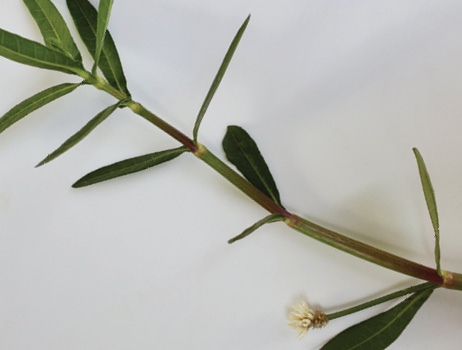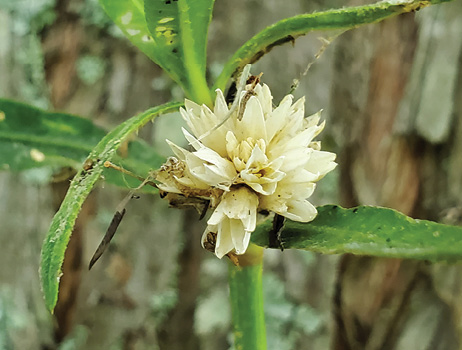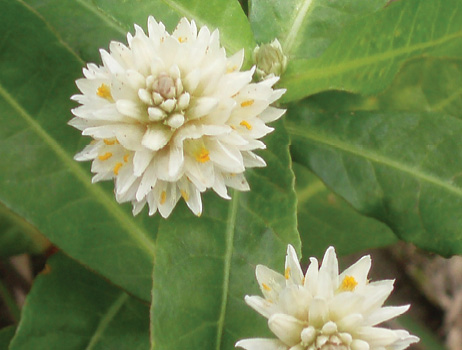Alligator Weed | Alternanthera philoxeroides
Emergent | Non-Native



Alligator weed is a non-native species originally from South America. It was first reported in Alabama in the late 1800s. Thick mats of alligator weed form at the shoreline and can extend many feet across the water’s surface.
Alligator weed has elliptical to lanceolate (sword-shaped) leaves that are paired opposite of each other on the stem. The stem is pale green to pink. Alligator weed can be mistaken for water primrose; however, the stems of alligator weed are hollow, while primrose stems are solid.
Flowers are small, round, white, and similar in appearance to terrestrial clover flowers. The petals are thin, and the flower is on a stem that is 3–5 inches in length.
This species outcompetes most native species with a similar growth form, and can reduce or eliminate shoreline access to anglers and wildlife. Alligator weed can also form floating islands that block sunlight from the water and phytoplankton. It is invasive and can spread easily from plant fragments left during control efforts.
Management Value
Alligator weed is highly invasive and not recommended for any application. This species should be eradicated on first appearance. Alligator weed is listed as a Class C noxious weed in Alabama.
Recommended Controls
Glyphosate, imazamox, imazapyr, and triclopyr can provide control of alligator weed for 2–3 months. Repeat applications may be necessary in areas with longer growing seasons or in very dense plant stands. Be sure to wet 100 percent of the exposed plant material.
Mixing imazapyr or imazamox with either triclopyr or glyphosate may provide better control than any single herbicide applied alone. Use the full recommended rate of each herbicide. Apply herbicide when temperatures are at least 60˚F, and spray all exposed plants.
Option 1: Glyphosate (5.4-pound formulation). For each gallon, mix 3.8 ounces of glyphosate, 1.3 ounces of surfactant, and the rest water. Spray to wet all exposed plants. Do not exceed annual herbicide rate limits as stated on the product label.
Option 2: Imazamox (1.0-pound formulation). For each gallon, mix 1.2 ounces of imazamox, 1.3 ounces of surfactant, and the rest water. Spray to wet all exposed plants. Do not exceed annual herbicide rate limits as stated on the product label.
Option 3: Imazapyr (2.0-pound formulation). For each gallon, mix 0.6 ounces of imazapyr, 1.3 ounces of surfactant, and the rest water. Spray to wet all exposed plants. Do not exceed annual herbicide rate limits as stated on the product label. Multiple applications will be required.
Option 4: Triclopyr (3.0-pound formulation). For each gallon, mix 5.1 ounces of triclopyr, 1.3 ounces of surfactant, and the rest water. Spray to wet all exposed plants. Do not exceed annual herbicide rate limits as stated on the product label.
The best approach to control this species is to treat ponds with herbicides when the water temperature is at least 60˚F and the plants are actively growing. For options 2 and 3, it is best to treat one-third of the pond at a time, with a week or more separating applications.
After the entire pond has been treated, a repeat application for the entire pond may be necessary to eliminate remaining plants. Following treatment, stock three to five triploid grass carp per acre to prevent infestation by other species. Stock 8- to 10-inch triploid grass carp in ponds that have established largemouth bass populations to avoid predation by bass.
Read and follow all chemical label instructions, especially the section on the use of personal protection equipment.

The information given here is for educational purposes only. References to commercial products, trade names, or suppliers are made with the understanding that no endorsement is implied and that no discrimination against other products or suppliers is intended.
Publication 3735-14 (POD-11-23)
By Wes Neal, PhD, Extension/Research Professor, Wildlife, Fisheries, and Aquaculture; Dennis Riecke, Fisheries Coordinator, Mississippi Department of Wildlife, Fisheries, and Parks; and Gray Turnage, PhD, Assistant Research/Extension Professor, GeoSystems Research Institute.
The Mississippi State University Extension Service is working to ensure all web content is accessible to all users. If you need assistance accessing any of our content, please email the webteam or call 662-325-2262.



